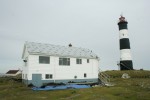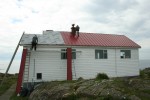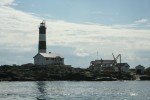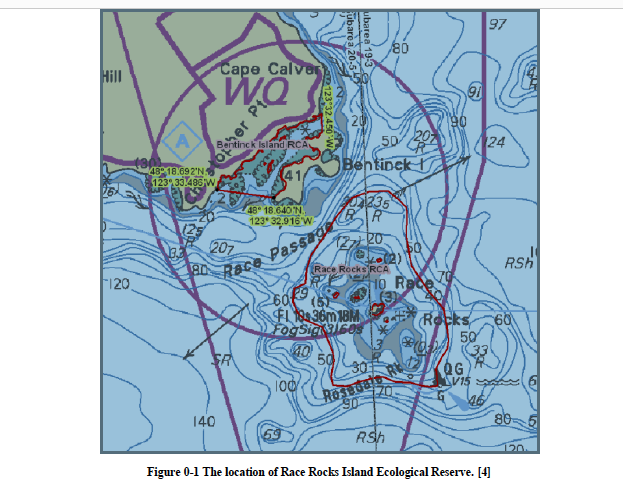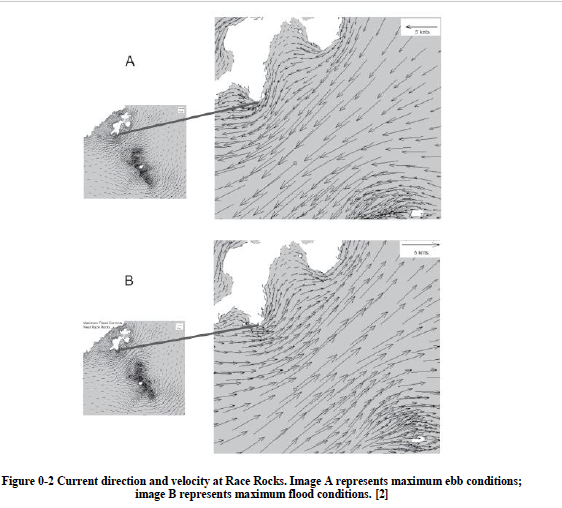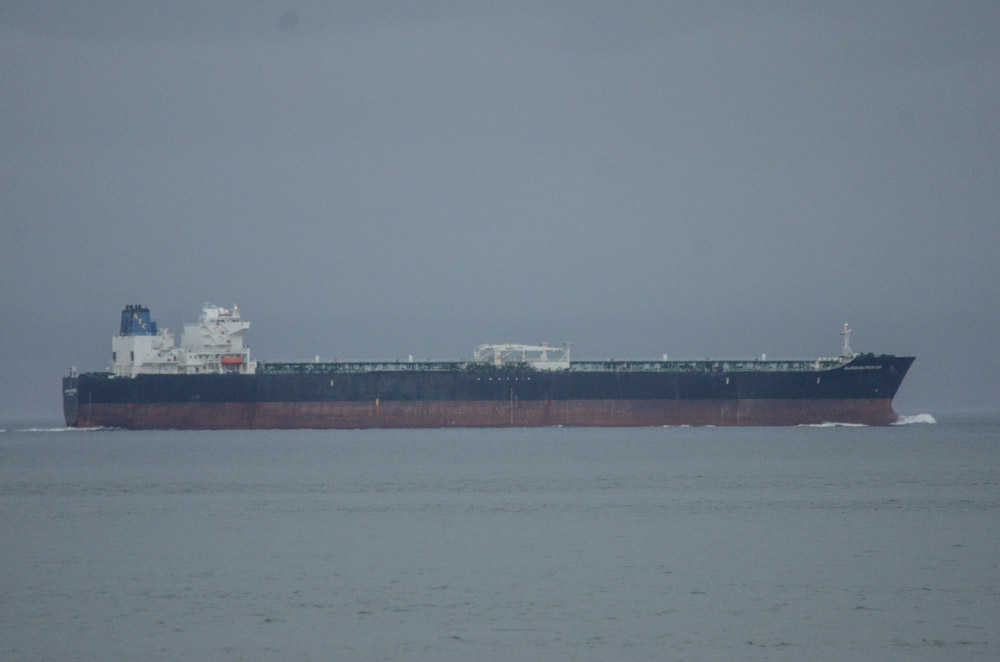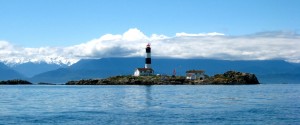| Daily Seawater Temperature and Density Record Shore Station | |||||
| Time Zone: PDT | |||||
| Station: Race Rocks Lightstation | |||||
| Month: ___March | Year: 2013 | ||||
| Observer: Pearson College UWC |
|||||
| Date | Time | Sea Temp. °C |
Jar Temp. °C |
Hydro- meter No. | Observed Density |
| 1 | 17:30:00 PM | 7.1 | 7.4 | 10,802 | 246.0000 |
| 2 | 17:45 | 6.8 | 7.2 | 10,802 | 245.0000 |
| 3 | 17:45 | 6.8 | 6.8 | 10,802 | 244.0000 |
| 4 | 8:30 | 6.6 | 6.5 | 10,802 | 241.0000 |
| 5 | 8:30 | 6.7 | 6.7 | 10,802 | 242.0000 |
| 6 | 10,802 | ||||
| 7 | 10,802 | ||||
| 8 | 9:40 | 6.9 | 6.9 | 10,802 | 240.0000 |
| 9 | 12:20 | 7.6 | 7.7 | 10,802 | 240.0000 |
| 10 | 13:40 | 6.9 | 7.0 | 10,802 | 240.0000 |
| 11 | 14:50 | 7.1 | 7.1 | 10,802 | 246.0000 |
| 12 | 16:30 | 7.0 | 7.0 | 10,802 | 248.0000 |
| 13 | 14:00 | 7.2 | 7.3 | 10,802 | 241.0000 |
| 14 | 17:40 | 7.0 | 7.0 | 10,802 | 246.0000 |
| 15 | 16:40 | 7.4 | 7.5 | 10,802 | 242.0000 |
| 16 | 18:30 | 6.7 | 6.7 | 10,802 | 244.0000 |
| 17 | 15:25 | 6.9 | 6.9 | 10,802 | 243.0000 |
| 18 | 9:40 | 6.7 | 6.7 | 10,802 | 244.0000 |
| 19 | 11:30 | 6.8 | 6.6 | 10,802 | 240.0000 |
| 20 | 12:00 | 7.0 | 7.2 | 10,802 | 242.0000 |
| 21 | 14:15 | 6.8 | 6.8 | 10,802 | 241.0000 |
| 22 | 10:15 | 6.7 | 6.7 | 10,802 | 244.0000 |
| 23 | 12:15 | 7.0 | 6.9 | 10,802 | 244.0000 |
| 24 | 13:30 | 6.8 | 6.8 | 10,802 | 241.0000 |
| 25 | 14:45 | 7.5 | 7.7 | 10,802 | 240.0000 |
| 26 | 10,802 | ||||
| 27 | 16:00 | 7.3 | 7.5 | 10,802 | 240.0000 |
| 28 | 18:00 | 7.4 | 7.5 | 10,802 | 241.0000 |
| 29 | 18:30 | 7.5 | 7.6 | 10,802 | 240.0000 |
| 30 | 19:00 | 7.5 | 7.6 | 10,802 | 242.0000 |
| 31 | 19:30 | 7.6 | 7.6 | 10,802 | 245.0000 |
| Mean* | * | 7.0 | 7.1 | 242.5714 | |
| Recorded by Race Rocks Marine Protected Area Guardian | |||||
Monthly Archives: March 2013
Marine Traffic
With the calm warm weather this week and approach of spring there has been a marked increase in vessel traffic in the reserve this week. We have been averaging 5-10 vessels a day, mainly eco tour boats like this large one in the photo.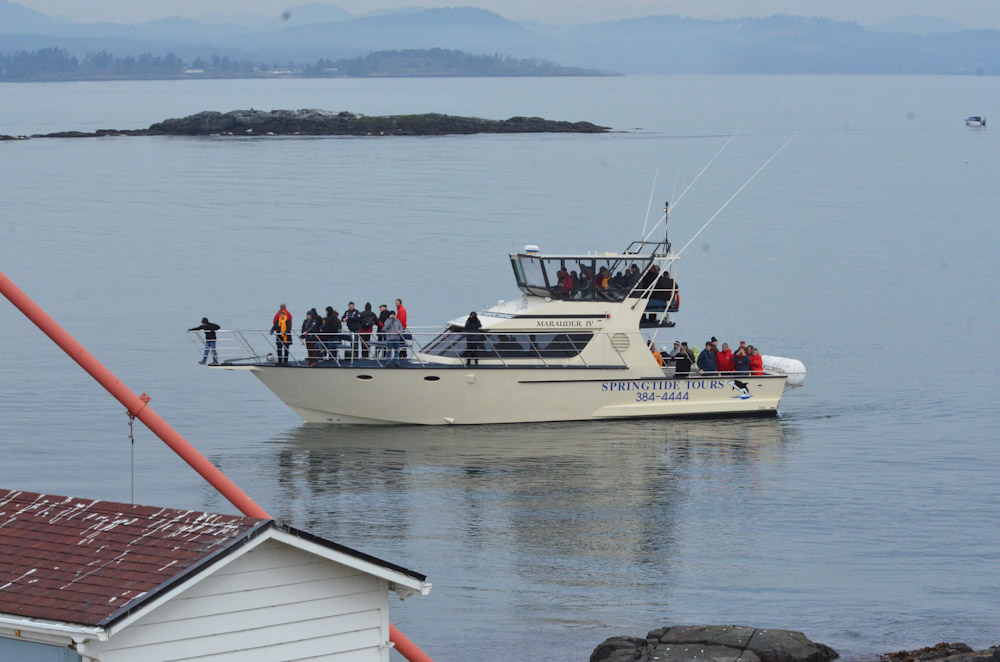 Recently there was an incident where a boater traveled through the reserve well in excess of the 7 knot speed limit. Fortunately we have a good relationship with Pedder Bay Marina and I was able to contact them and someone spoke with the operator. In my experience, the staff and management at the marina are always very cooperative and are willing to work with us to ensure that boaters are aware of the rules and that repeat offenders get reported or restricted from using their facilities. Thanks Pedder Bay Marina!
Recently there was an incident where a boater traveled through the reserve well in excess of the 7 knot speed limit. Fortunately we have a good relationship with Pedder Bay Marina and I was able to contact them and someone spoke with the operator. In my experience, the staff and management at the marina are always very cooperative and are willing to work with us to ensure that boaters are aware of the rules and that repeat offenders get reported or restricted from using their facilities. Thanks Pedder Bay Marina!
Sea Otter at Race Rocks
Misery has been off the main island and out of sight since about March 16. A few female elephant seals have been around, there have been 4 or 5 on Middle rock for the past few days.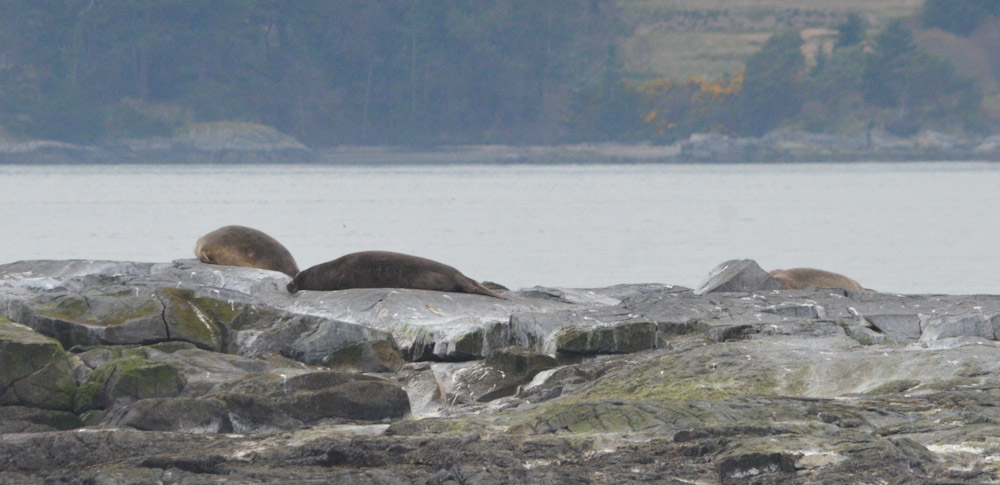 On the 26th I saw a Sea Otter off the south side of the island. It was mostly swimming on its back and at one point had a sea urchin it was eating on its belly. A few seals followed it as it swam towards middle rock.
On the 26th I saw a Sea Otter off the south side of the island. It was mostly swimming on its back and at one point had a sea urchin it was eating on its belly. A few seals followed it as it swam towards middle rock.
See this file on one previous occurrence of Sea Otters at Race Rocks 
Tomorrow is the last day of my 4 month shift at Race Rocks. Mike will be returning to take over.
Roofing, Flooring
I returned to the island on March 26 after spending about a week off island. While I was away a 55+ knot wind hit the island. The Guest house has been losing shingles all winter, this time it took a whole section of the roofing and tar paper off and blew it all over the island. The guardian said he heard pieces hitting the main house. A roofing crew has been out here each day since Tuesday and have nearly finished installing a new metal roof. There has also been two guys working on installing new vinyl floors in the guest house.
Tags used on racerocks.ca
For the use of the Ecoguardians in editing. To check on the posts tagged with a name below, use the “slug” name in the SLUG HERE space in the URL below.
https://www.racerocks.ca/tag/ SLUG HERE/
| Name | Slug | Posts | ||
|---|---|---|---|---|
| airplane | airplane | 1 | ||
| alternate energy | alternate-energy | 15 | ||
| Amsinckia spectabilis | amsinckia-spectabilis | 1 | ||
| Angus Matthews | angus-matthews | 6 | ||
| artist | artist | 1 | ||
| bald eagle | bald-eagle | 94 | ||
| banded | banded | 1 | ||
| barn swallow | barn-swallow | 2 | ||
| barred owl | barred-owl | 1 | ||
| Bertha | bertha | 34 | ||
| biological classification | biological-classification | 1 | ||
| bioluminescence | bioluminescence | 2 | ||
| Black brandt goose | black-brandt-goose | 2 |
| Black Oystercatcher | black-oystercatcher | 70 | ||
| Black- bellied plover | black-bellied-plover | 1 | ||
| black-turnstone | black-turnstone | 11 | ||
| blasting | blasting | 10 | ||
| blenny | blenny | 1 | ||
| boat rescue | boat-rescue | 4 | ||
| boat speeding | boat-speeding | 2 | ||
| bonapartes gull | bonapartes-gull | 1 | ||
| branded | branded | 20 | ||
| brandt’s cormorant | brandts-cormorant | 6 | ||
| Brown algae | brown-algae | 6 | ||
| brown pelican | brown-pelican | 5 | ||
| bryozoan | bryozoan | 1 | ||
| Cackling goose | cackling-goose | 6 | ||
| california gull | california-gull | 1 | ||
| california sea lion | california-sea-lion | 7 |
| california sealion death | california-sealion-death | 1 | ||
| Canada goose | canada-goose | 48 | ||
| Caspian Tern | caspian-tern | 3 | ||
| census | census | 8 | ||
| chick | chick | 6 | ||
| chiton | chiton | 1 | ||
| Chlorophyta | chlorophyta | 1 | ||
| Christmas bird count | christmas-bird-count | 4 | ||
| Chunk | chunk | 26 | ||
| coast guard helicopter | coast-guard-helicopter | 1 | ||
| common murre | common-murre | 3 | ||
| Cooper’s Hawk | coopers-hawk | 1 | ||
| cormorant | cormorant | 30 | ||
| COSEWIC | cosewic |
| crow | crow | 8 | ||
| DFO | dfo | 4 | ||
| divers | divers | 24 | ||
| dnd | dnd | 4 | ||
| DND blasting | dnd-blasting | 3 | ||
| double-crested cormorant | double-crested-cormorant | 1 | ||
| dunlin | dunlin | 7 | ||
| e-seal pup F076 | e-seal-pup-f076 | 28 | ||
| eagle | eagle | 2 | ||
| ecological monitoring | ecological-monitoring | 1 | ||
| ecological niche | ecological-niche | 1 | ||
| Ecological Reserve | ecological-reserve | 1 | ||
| ecological restoration | ecological-restoration | 2 | ||
| ecological succession | ecological-succession | 1 | ||
| ecosystem | ecosystem | 1 | ||
| ectoproct | ectoproct | 2 |
| elephant seal | elephant-seal | 243 | ||
| elephant seal pup | elephant-seal-pup | 47 | ||
| energy | energy-2 | 2 | ||
| enhydra lutris | enhydra-lutris | 1 | ||
| entanglement | entanglement | 5 | ||
| environmental impact | environmental-impact | 4 | ||
| fiddleneck | fiddleneck | 1 | ||
| First nations | first-nations | 3 | ||
| fish | fish | 6 | ||
| fish balls | fish-balls | 8 | ||
| flares | flare | 1 | ||
| fog | fog | 12 | ||
| fox-sparrow | fox-sparrow | 1 | ||
| Friends of Ecological Reserves | friends-of-ecological-reserves | 1 | ||
| fuel delivery | fuel-delivery | 1 |
| fur seal | fur-seal | 1 | ||
| glaucous-winged-gull | glaucous-winged-gull | 65 | ||
| Great Blue Heron | great-blue-heron | 1 | ||
| Great horned owl | great-horned-owl | 4 | ||
| Greater White-fronted Goose | greater-white-fronted-goose | 7 | ||
| green urchin | green-urchin | 1 | ||
| Green Winged Teal | green-winged-teal | 3 | ||
| grey whale | grey-whale | 1 | ||
| harbour seal | harbour-seal | 40 | ||
| harlequin duck | harlequin-duck | 23 | ||
| Heermann’s gull | heermanns-gull | 1 | ||
| helicopter | helicopter | 1 |
| herring balls | herring-balls | 2 | ||
| herring gull | herring-gull | 6 | ||
| historical artifacts | historical-artifacts | 1 | ||
| horned-lark | horned-lark | 1 | ||
| hummingbird | hummingbird | 2 | ||
| humpback whale | humpback-whale | 4 | ||
| iceland gull | iceland-gull | 1 | ||
| illegal fishing | illegal-fishing | 3 | ||
| injury | injury | 44 | ||
| integrated energy system | integrated-energy-system | 12 | ||
| intertidal | intertidal | 2 | ||
| jellyfish | jellyfish | 2 | ||
| job description | job-description | 1 | ||
| kayak | kayak | 9 | ||
| kelp | kelp | 1 | ||
| killdeer | killdeer | 3 | ||
| Lighthouse | lighthouse | 3 | ||
| lightkeeper | lightkeeper | 9 | ||
| lightning | lightning | 1 | ||
| limpet | limpet | 1 | ||
| ling cod | ling-cod | 1 | ||
| long-billed-dowitcher | long-billed-dowitcher | 1 | ||
| mallard | mallard | 2 | ||
| marine debris | marine-debris | 2 | ||
| marine mammal disturbance | marine-mammal-disturbance | 1 | ||
| Marine Pollution | marine-pollution | 4 | ||
| mating | mating | 4 | ||
| Mew gull | mew-gull | 2 | ||
| migrant | migrant | 3 | ||
| Mink | mink | 1 | ||
| Minke whale | minke-whale | 1 | ||
| Misery | misery | 22 | ||
| moulting | moulting | 3 |
| nest | nest | 10 | ||
| Northern Fur Seal | northern-fur-seal | 1 | ||
| northern sealion | northern-sealion | 10 | ||
| octopus | octopus | 2 | ||
| offload | offload | 1 | ||
| oil spill | oil-spill | 4 | ||
| Orca | orca | 57 | ||
| osprey | osprey | 1 |
| Pam Birley | pam-birley | 12 | ||
| pelagic cormorant | pelagic-cormorant | 5 | ||
| Pelican | pelican | 15 | ||
| peregrine falcon | peregrine-falcon | 5 | ||
| Phaeophyta | phaeophyta | 5 | ||
| pigeon guillemot | pigeon-guillemot | 22 | ||
| pineapple weed | pineapple-weed | 1 | ||
| plant | plant | 1 | ||
| predation | predation | 28 |
| puget sound king crab | puget-sound-king-crab | 1 | ||
| pup | pup | 18 | ||
| pup3 | pup3 | 1 | ||
| quadrat | quadrat | 1 | ||
| rain | rain | 2 | ||
| rainbow | rainbow | 3 | ||
| Raisa | raisa | 1 | ||
| rare species | rare-species | 3 | ||
| raven | raven | 5 | ||
| red knot | red-knot | 2 | ||
| red phalarope | red-phalarope | 1 | ||
| red tailed hawk | red-tailed-hawk | 2 | ||
| red-necked phalarope | red-necked-phalarope | 0 | ||
| research gaps | research-gaps | 1 | ||
| rhinocerous auklet | rhinocerous-auklet | 2 | ||
| Rhodophyta | rhodophyta | 2 | ||
| river otter | river-otter | 10 | ||
| rock sandpiper | rock-sandpiper | 1 | ||
| rr.com project | rr-com-project | 4 | ||
| Ryan | ryan | 2 | ||
| salinity | salinity | 1 | ||
| salmon | salmon | 1 | ||
| sanderling | sanderling | 4 | ||
| savannah sparrow | savannah-sparrow | 3 | ||
| scarlet | scarlet | 5 | ||
| sea otter | sea-otter | 3 | ||
| sealion | sealion | 109 | ||
| sealion pup | sealion-pup | 1 | ||
| Seawater data | seawater-data | 1 | ||
| second nature | second-nature | 1 | ||
| shipping | shipping | 2 | ||
| slash | slash | 15 | ||
| smoke | smoke | 1 | ||
| snorkel | snorkel | 1 | ||
| snow | snow | 10 | ||
| snow bunting | snow-bunting | 1 | ||
| snowy owl | snowy-owl | 1 | ||
| solar | solar | 2 | ||
| song sparrow | song-sparrow | 1 | ||
| sound pollution | sound-pollution | 1 | ||
| squall | squall | 11 | ||
| starling | starling | 4 | ||
| storm | storm | 2 | ||
| student | student | 38 | ||
| submarine | submarine | 2 | ||
| sunrise | sunrise | 1 | ||
| sunset | sunset | 1 | ||
| surfbird | surfbird | 7 | ||
| surfing | surfing | 1 | ||
| tagged | tagged | 31 | ||
| tanker traffic | tanker-traffic | 2 | ||
| tattler | tattler | 1 | ||
| temperature | temperature | 7 | ||
| Thayer’s gull | thayers-gull | 2 | ||
| Thesis | thesis | 1 | ||
| tidal energy | tidal-energy | 8 | ||
| Tom Sampson | tom-sampson | 1 | ||
| transect | transect | 1 | ||
| Trev and Flo Anderson | trev-and-flo-anderson | 1 | ||
| turkey Vulture | turkey-vulture | 3 | ||
| underwater camera | underwater-camera | 1 | ||
| visitors | visitors | 2 | ||
| Wandering Tattler | wandering-tattler | 2 | ||
| weather | weather | 1 | ||
| western grebe | western-grebe | 2 | ||
| western gull | western-gull | 1 | ||
| western sandpiper | western-sandpiper | 1 | ||
| whale | whale | 7 | ||
| whale watching | whale-watching | 40 | ||
| whimbrel | whimbrel | 6 | ||
| White-fronted goose | white-fronted-goose | 0 | ||
| wind | wind | 6 |
Carrier, Vulture, Relief Guardian
Today a relief guardian came out to take my place for about a week. A pair of Turkey Vultures landed on the island and an air craft carrier passed by in the distance behind Rosedale Reef. Oddly, on close examination this carrier appears to be carrying cars not aircraft on its upper deck.
http://www.racerocks.com/racerock/eco/taxalab/2006/cathartesa/cathartesa.htm
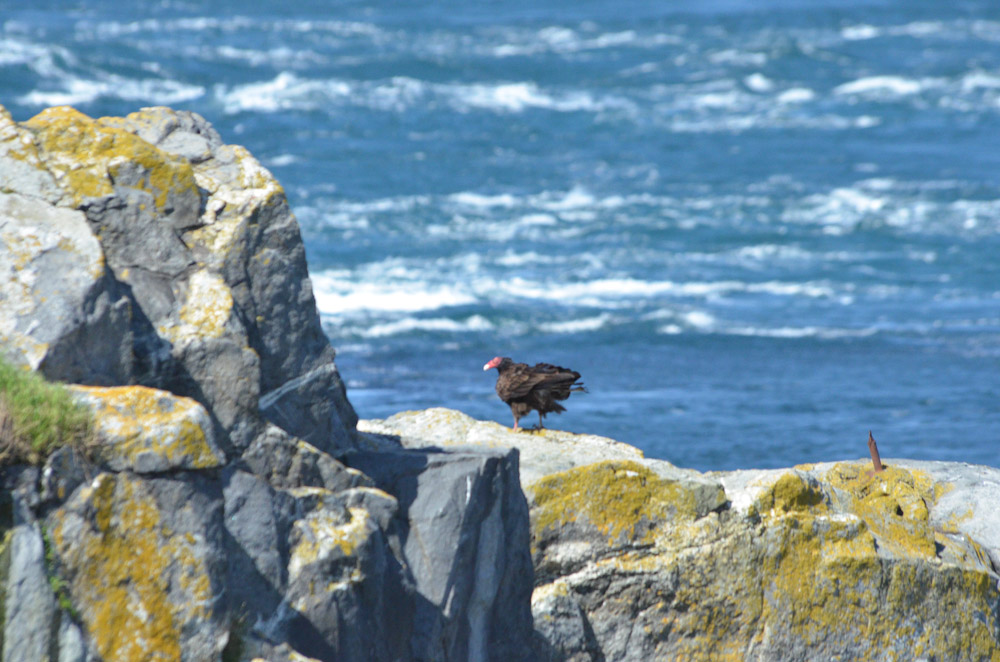
See this file on Turkey Vultures at Race Rocks
Cathartes aura: Turkey vulture
Alex Fletcher took this picture of a turkey vulture and included it in the Race Rocks Log of . We occasionally see Turkey Vultures at Race Rocks, rarely landed but often wheeling in the air. In October when migrating, they gather at this southern end of Vancouver Island, working up on the thermals until they have enough altitude and the conditions are right to cross the Strait of Juan de Fuca
| Carol Slater noted in The Daily Log, Thursday, March 28, 2002 Good Evening TEMPERATURE: Max. 8.1 ºC »» Min. 6.0 ºC »» Reset 7.1 ºC »» Rain 2.6 mm MARINE LIFE: 4 Bald Eagles – 3 mature, only one pair of Geese today. Another wet and windy day but did have some visitors of note-just before noon 4 Turkey Vultures landed on the ridge just west of the Learning Centre. The other birds were somewhat wary but did not try to drive away the big vultures as they do with the eagles.The geese were very curious and waddled over to have a look all the time waving their necks back and forth. |
| Unfortunately by the time the geese made their way from the flagpole to where the vultures were, they had taken off towards Bentinck Island.Turkey Vultures often land here during the fall migration but this is the first time I can remember seeing them in the spring.The small elephant seal is still hauled out on the ramp,it’s nose just 3 metres from the boat house door, quite comfortable and unconcerned with us passing by even just inches away.
Other references to turkey vulture sightings may be found here: |
CLASSIFICATION:
Domain Eukarya
Kingdom Animalia
Phylum Chordata
Subphylum Vertebrata
Class Aves
Order Cathartiformes
Family:Cathartidae
Genus Cathartes
Species aura
Common Name: Turkey Vulture
and Image File |
 The Race Rocks taxonomy is a collaborative venture originally started with the Biology and Environmental Systems students of Lester Pearson College UWC. It now also has contributions added by Faculty, Staff, Volunteers and Observers on the remote control webcams. The Race Rocks taxonomy is a collaborative venture originally started with the Biology and Environmental Systems students of Lester Pearson College UWC. It now also has contributions added by Faculty, Staff, Volunteers and Observers on the remote control webcams. |
The Tidal Current Turbine Energy Project in the Race Rocks Ecological Reserve
PT-13: Coastal and Ocean Engineering ENGI.8751 Undergraduate Student Forum Faculty of Engineering and Applied Science, Memorial University, St. John’s, NL, Canada MARCH, 2013 Paper Code. (PT-13 – Brown)
PT-13 Brown P.1
The Tidal Current Turbine Energy Project in the Race Rocks Ecological Reserve
Erika Lee Brown
Memorial University of Newfoundland
St. John’s, Newfoundland, Canada
ELBrown@mun.ca
ABSTRACT
There is a predicted potential of 42 000MW stored in tidal energy off the coast of Canada which remains widely untapped by the energy industries.[1] Although there has been significant research and development done in the tidal energy sector, it has been a challenge to develop a cost efficient system which has a minimal environmental impact.
In 2006, the first tidal current generator to be built and installed in Canada was deployed north of the Middle Islands in the center of the Race Rocks Ecological Reserve off the coast of British Columbia. The current generator prototype was part of a six year joint research venture between Clean Current and the Race Rock project. The project aided to power Race Rocks using a combination of alternative energy technology to minimize the environmental impact of the facilities in the reserve while providing bases for testing of structural materials of the generator.
After numerous interruptions in power supply were experienced due to mechanical and electrical problems, the final phase of the project was completed in September 2011. The generator was retrieved from the seabed and transported to Vancouver for structural analysis.
The following paper will discuss the parameters of the study, as well as the challenges and problems encountered with the deployment, maintenance and retrieval of the tidal current system. A brief investigation of the outlook of tidal current generator systems as a means of power generation within Canada will also be completed.
1 INTRODUCTION
The Race Rocks located at 123° 31’ 85W latitude and 48° 17’ 95N longitude in the Juan de Fuca Strait off the coast of Vancouver Island, British Columbia is an ecologically diverse marine area. In 2001, Race Rocks was granted Ecological Reserve Status in British Columbia, Canada as Race Rocks Ecological Reserve. The reserve encompasses the main island of Great Race, as well as eight smaller islands, the water column and the seabed out to a depth of 36.6 m. [2] The designation of reserve status was created in the mid 1970s in the province in order to preserve a unique or representative ecosystem so that they may serve for research, education and a baseline for monitoring ecological change due to human encroachment. [3]
The islands within the Race Rocks Reserve do not have any permanent resides, however there are research and accommodation facilities present as the area is frequently inhabited on a temporary bases by various researchers and professors and students from Lester B. Pearson College. These facilities were electrically supplied by 15 and 25 kilowatt diesel generators.[5]
While the area is unique due to its ecological diversity, Race Rocks is also known for the  high currents present for which it was named. It is because of these high currents and the need to assist mariners with the navigation hazards that the lighthouse was establish on Great Rock in 1860. Although the lighthouse is located within the Ecological Reserve, the surrounding land is under the jurisdiction of the Canadian Coast Guard. [2] Due to maintenance costs, the Coast Guard switched powering of the lighthouse to solar energy. It was this transition to self-sufficient, low environmental impacting energy, which lead the wardens of the Race Rock Ecological Reserve to investigate similar alternative forms of energy.
high currents present for which it was named. It is because of these high currents and the need to assist mariners with the navigation hazards that the lighthouse was establish on Great Rock in 1860. Although the lighthouse is located within the Ecological Reserve, the surrounding land is under the jurisdiction of the Canadian Coast Guard. [2] Due to maintenance costs, the Coast Guard switched powering of the lighthouse to solar energy. It was this transition to self-sufficient, low environmental impacting energy, which lead the wardens of the Race Rock Ecological Reserve to investigate similar alternative forms of energy.
2 OPPORTUNITIES
Energy BC predicts that there is 42 000MW of stored tidal energy off the coasts of Canada, with approximately 7 000MW located in accessible regions along the east and west coasts which remain widely untapped. [1] The renewable energy industry is growing, with a strong research and development sector. In Canada, the majority of the research and implementation of tidal energy has been developed in barge type systems. This type of system has raised environmental concerns as they affect the natural tidal flow, as well as have notable negative impact on the marine environment.
An alternative method of extracting energy from the tides is through the use of tidal current turbines. These systems aim to utilize the natural tidal flow to turn the blades of a turbine, hence generating power. Initial research into harnessing tidal current energy revealed promising decreases in environmental impact to turbine sites and marine organisms. Prior to this case study, the design, construction, and deployment of a tidal current generator had not taken place in Canada. The strong research and tidal conditions indicative of the Race Rocks Reserve made it an ideal test site of the performance and marine impact of the new turbine design.
The bathometry and geometry of the Juan de Fuca Strait attest to the flow profile and characteristics that have been observed. The strait experiences a mixture of semi-diurnal and diurnal tides, shown in Figure 0-1, which causing upwelling of vital nutrients adding to the creation of the diverse ecosystem of the area.
As mentioned previously, Race Rocks has been historically identified as an area with high velocity tidal currents. Figure 0-2 below, from Fisheries and Oceans Canada, shows that the current can reach up to six knots through the Juan de Fuca Strait and are at their strongest at Race Rocks due to the narrowing of the channel.
As mentioned previously, Race Rocks has been historically identified as an area with high velocity tidal currents. Figure 0-2 below, from Fisheries and Oceans Canada, shows that the current can reach up to six knots through the Juan de Fuca Strait and are at their strongest at Race Rocks due to the narrowing of the channel.
Figure 0-2 Current direction and velocity at Race Rocks. Image A represents maximum ebb conditions; image B represents maximum flood conditions. [2]
3 PROJECT DESCRIPTION
The catalyst for the project was the desire of the reserve warden to have the island facilities operating in a sustainable manner using renewable energy. Prior to the commencement of the project, the island energy needs were provided by two diesel electric generators. Due to the future projected costs of the generators along with the negative effect on the marine environment as a result of the refueling and vibrations, the Integrated Energy Project was begun in Race Rocks in 1998.
1998. PT-13 Brown P.5
The desire of using sustainable energy and the unique tidal characteristics of Race Rocks made the site a very suitable location for harnessing tidal energy. Through the collaboration of Lester B. Pearson College with the Clean Current Energy Company, the Race Rocks Tidal Current Turbine Project was conceived. Pearson College benefited from the partnership by having an active educational and research opportunity and by receiving ongoing technical and monetary support from Clean Current throughout the project.
The objectives of the project partners were to:
provide sustainable energy to Race Rocks replacing the diesel generators,
contribute to the educational experience of Person College students
monitor the impact of the tidal turbine on the surrounding ecosystems,
test the seaworthiness of the turbine,
demonstrate the maintenance process for tidal current generators,
perfect the turbine structure, and
maximize turbine operation.
Clean Current Energy Company had developed a concept for the first tidal current turbine prototype to be designed and built in Canada. It was determined that the Race Rocks site would be an ideal location for testing the impact, functionality and structural integrity of the prototype.
3.1 Prototype
The tidal current turbine installed was a 1:5 scale prototype of the Clean Current Energy Company concept design. Due to the change in tidal current, the system was built to function bi-directionally. The turbine had a projected capacity of 65kW and a 3.5m blade diameter. [6]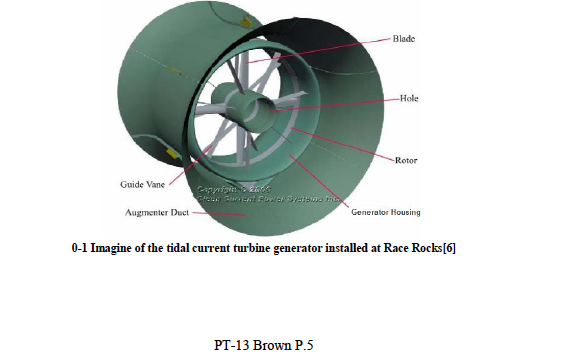
3.2 Project Timeline
Throughout the first half of 2006, the site was prepared for the tidal current energy system on Race Rocks. The boathouse on Great Race was converted into an energy storage facility with the installation of batteries and various types of electronic equipment. After a turbine site had been confirmed, the site was dredged, drilled and piles were installed. Four cables to transmit the produced energy from the turbine to the batteries were laid along the seafloor from the turbine site to the boathouse. Concrete blocks were placed alongside the underwater cable to protect them from winter storm surges and a trench was dug to accommodate the cables on land. [7] On September 27, 2006, the turbine was installed in the middle islands in the center of the reserve with a 5m clearance from the water surface.
After disappointing performance results from the turbine, it was retrieved and underwent a refit. The turbine was upgraded to include stainless steel bearings, a new lubrication and electrical wire protection system, a new reinforced fiberglass augmenter duct, and reinforced struts. Along with these new additions, the turbine blade configuration was also modified.[8] Clean Current redeployed the revamped system October 17, 2008.
The portion of the trial to be performed at Race Rocks came to an end on September 17, 2011. The turbine was removed from the sea floor by Clean Current Staff and returned to Vancouver to undergo structural analyses.
4 PROJECT CHALLENGES
Throughout the life of the project, there were a number of challengers which the partners had to overcome.
Installation of the turbine proved to be a challenge due to the high current velocities in the region. It was necessary to time the installation so that it could take place during slack tide and ensure that the majority of the installation took place before the tide turned. [8]
The first operational problem encountered in the project was an unexpectedly rapid deterioration of the turbine bearings. This caused the system to be raised in April 2007 for them to be changed out.
Throughout the life of the Race Rocks tidal project, there were a number of interruptions in energy production and transmission to the island. Problems were noted with the fiber optic cable manufacturing which lead to electrical leakage. [8]
Although the estimated generator output was 65kW, the average every production was only 12.5 kW.[9] This led to the turbine being refit and redeployed in 2008.
5 FUTURE WORK
The involvement of Race Rock Ecological Reserve, and hence Lester B. Pearson College, ended when the turbine was extracted in 2011. At that point, the infrastructural and material component of the project was continued solely by Clean Current Energy Company.
The results of the structural analysis of the turbine infrastructure due to prolonged exposure to the ocean have yet to be released. Once a better understanding of the effects ocean environment can have on the materials used for the tidal current turbine is obtained, the design prototype will be adjusted to better suit the harsh environments for which tidal current extraction can be maximized.
It is the hope that the results of this project will enable other projects of its kind to be initiated along the Canadian coasts. The end goal is for the prototype to be brought to the final design phase, allowing for commercial tide current turbines to be installed and producing significant energy to the Canadian public.
6 CONCLUSION
The installation of Canada’s first tidal current turbine generator prototype designed by Clean Current Energy in the Race Rocks Ecological Reserve was a milestone in the Canadian renewable energy industry. The tidal current profile and marine ecological information within Race Rocks made it an ideal location to not only test the structural integrity of the turbine prototype but also its environmental impact on marine life.
Although the power supplied by the tidal current turbines to Great Race Island was inconsistent throughout the life of the project, it was a valuable asset to the Race Rock Ecological Reserve’s sustainable energy program. The energy provided by the generator was able to supply a base storage of electricity to the solar power batteries now in use on the island, therefore ensuring that the island be non-consumptive in its energy usage.
Not only did the program provide a foundation for the energy objectives of Race Rocks, but the data obtained from the turbine prototype will enable Clean Current to upgrade their design to better meet the industry needs. While the results of the structural analysis are still unknown, they will greatly contribute to the further research and development of the tidal energy industry.
|
REFERENCES [1] |
E. BC, “Tidal,” Tidal, 2012. [Online]. Available: http://www.energybc.ca/profiles/tidal.html. [Accessed 19 January 2013]. |
||||||||||||||
|
[2] |
C. Wright and J. Pringle, “Race Rocks Pilot Marine Protected Area: An Ecological Overview,” Fisheries and Oceans Canada, Sidney, British Columbia, 2001
|
Alaskan Frontier
There is a constant flow of shipping traffic passing by Race Rocks to and from Seattle and Vancouver each day. Once in a while there are ships that are very loud with a low, rumbling sound that I can hear and feel in the house as they pass by. This oil tanker, the Alaskan Frontier, on its way West towards the infamous Port of Valdez, Alaska, was one of the loud ones. The information below was obtained from http://ais3.siitech.com/VTSLite/AView.aspx which tracks all major marine traffic in the area.
This ship may have been louder than others because as is shown in the photo it is sitting quite high out of the water, likely empty on its way to fill up on crude in Alaska. Which means that when carrying a load it would be projecting this sound underwater, maybe louder, where sound travels further. Which begs the question: how much noise pollution are we subjecting marine mammals to in this area? What impact does it have on their ability to communicate, hunt, and navigate? It would be great to be able to listen to the sound underwater and measure these sound levels at Race Rocks.
As well as the sound, there is the unregulated emissions from these ships. On a clear busy day there is a haze that hangs over the ocean to the East. Sometimes I can smell and taste diesel fumes out here when ships are miles away. On top of this of course is the constant risk of an accident; it doesn’t have to be a tanker to spill fuel.
With the potential of an increase in tanker traffic and tanker size in this area, to handle increased production from the Tar Sands, the focus of environmental groups seems to be on the risk of increasing traffic. I think the question we should be asking is what is the impact and risk of the existing traffic? Are there any impact studies being done? More broadly: Do we value the ocean more as an access route for cheap goods or as a habitat for marine life? What is the true cost of cheap shipping? What is acceptable risk?
On a related note, I have not seen many whales this winter.
|
Update on MPA process for the waters within the Race Rocks ER#97
The MPA process for the federally controlled waters within the Provincial Marine Ecological Reserve started In 2000. A proposal was submitted by a DFO -convened Advisory Group composed of Sports fisheries, First Nations, science representatives, Provincial Parks, Canadian Wildlife Service, Environment Canada, Pearson College representatives, whale watching groups, diving groups and several environmental NGOs . This proposal was changed for the Gazetting process by the Department of Fisheries office in Ottawa, and the final result in the Canada Gazette was unacceptable to all members of the Advisory Board. You can read about that and a Master’s thesis documenting the process on the racerocks.com website.
The proposal languished until 2009 when DFO again asked the Advisory Board to reassemble. This month, after several years of separate negotiations with First Nations, an update was given to those members of the advisory group who were still interested in attending.
Angus Matthews provided this update on the Race Rocks MPA process.
Short version… on track but likely to take two more years.
If you want details…
We had a good meeting yesterday with Glenn Rasmussen, the DFO manager responsible for the proposed MPA. Arron Reith the First Nations consultant was also present. We had requested the meeting to receive an update on progress since the Race Rocks Advisory Board completed its work almost two years ago. The highlights are…
- Additional meetings were held with representatives of the ecotourism/whale watching operators and a satisfactory protocol was worked out in accordance with previous advisory board discussions. There will not be fee based permits but operators will be required to register and file use plans each year.
- First Nations consultation has proceeded with three of the four bands. Esquimalt band has not engaged in discussions. There has apparently been considerable progress with the other three bands and written confirmation will be sought over the next few months.
- The First Nations discussions are likely to result in some DFO funded co-operative education programs with First Nations and Pearson College related to Race Rocks. A DFO/First Nations group has been formed to make these arrangements.
- DFO has accommodated Douglas Treaty rights and First Nations will not be subject to a no-take regulation although there is goodwill among First Nations towards voluntary conservation measures.
- From a governance point of view, the Minister retains sole responsibility for decision-making (it’s in the Act). First Nations and all stakeholders are able to provide advice to the Minister through staff.
The regulation still needs to be finalized from the working draft and approved at the regional staff and deputy minister level. This is expected to occur two to four months after endorsement is received from First Nations. It is then off to Ottawa where legal work will take about eight months and then it goes on the Minister’s desk. Once it clears the very big pile on the desk the regulation will be made public and go to the Gazette stage for public comment for 60 to 90 days. It sounds like the regulation is still in line with the last version approved by the RR Advisory Board. There is not much we can do until it reaches the Minister. At that point encouragement would be helpful.
Don’t despair! Look on the bright side; two more years is only 10% of the time since this process began 20 years ago!
Angus Matthews
Executive Director
Shaw Ocean Discovery Centre

